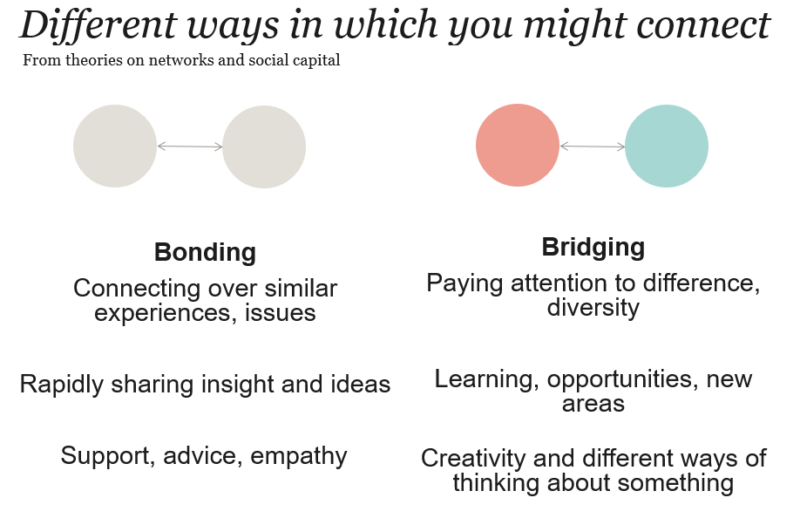How many networks are you part of? We all belong to networks, often multiple networks within and outside of our work contexts.
I have Type 1 Diabetes, the groups and networks that I am part of span everything from park run for diabetes (granted, it’s a little quiet at the moment), to diabetes technology groups helpfully focussed on sharing and learning about the tech, plus the diabetes community on Twitter. I dip in and out, paying attention to them all at once feels a bit much at times. My focus tends to be on sharing my experience, taking tips from others and sharing in the frustration that eating pizza is a blood sugar roller coaster ride. I make connections where I can and there is a sense of being in it together.
In Q, we recognise that there are a set of relational skills required in order to bring people together, to take the silos that we see and start to bridge the divides
I haven’t mindfully considered the key roles that help these networks continue to be energising spaces. Though, when I reflect, I am aware of who the people are playing a more focussed network leadership role. I can recognise those that prompt and nudge conversations or look to make links with other networks or groups.
In Q, we recognise that there are a set of relational skills required in order to bring people together, to take the silos that we see and start to bridge the divides. We have been working to develop a learning series focussing on network leadership, or “network weaving”, a term with roots in June Holley’s theories. Network weaving describes a set of skills that enables a network to be more effective.
I’ve got three general reflections to share with you on networks (not just because I like things in threes):
When you connect with people and have conversations, there are different ways in which you might connect
We have in the past described ‘bridging and bonding’ conversations to highlight the different ways in which members connect across Q.
Bonding is where the conversation focuses on finding out that you have shared or common experience, or interest. The benefits of those types of conversations are that you can develop connections quickly, share insight, experiences, empathize or even provide support or advice if that’s appropriate.
A bridging conversation is where you might find something that’s different between you, or that you could potentially learn from each other, it might stimulate new ideas or thinking, help provide some diversity of thought, even some challenge. These conversations can cross divides.

Do you recognize these as ways of connecting across Q?
Network weavers (or leaders) seek opportunities for cross-boundary learning and develop an awareness of the networks that are around them; acting as a catalyst for self-organising groups. This bridging activity contributes to a healthier network.
The importance of building your awareness of the key roles within your network; being more intentional about the role you want to play
Matthew Mezey wrote recently about the importance of understanding that different relational roles are needed for successful change. Have you ever been part of a group or conversation and asked yourself; “who is missing?”.
In some personal network analysis you might ask yourself, who is playing leadership roles within the community? Who is not, but should be? Are the right connections in place?
There will be voices you or I are not hearing in our networks and it’s increasing our awareness and periphery that’s important. There are tools that can support building this understanding. Or you can start by being more intentional about bringing people together when you spot a shared interest. You never know where that might lead.
Reflect on what you think will make your network(s) better
There is literature and evidence that supports a whole host of skills, roles, behaviours and structures that enable networks to thrive. Network Weaving focusses on four key roles within networks. It is the combination of these along with distributed leadership and power that enables a network to thrive and have impact.
A network weaver works to make networks better or healthier, helping to identify interests and challenges. They:
- Identify others and invite them into the space; bring voices together
- Recognise and organise roles, be intentional about them
- Focus on the relationships within the network, ensure everyone is involved
- Work with different perspectives.
This autumn we will be bringing Q members together to join a learning series that focusses on network weaving, more commonly known as network leadership.
Everyone can develop network leadership capability and play a vital role in network development and growth. This opportunity will support you to more deeply understand and optimise your role, relationships and activity in networks that are seeking to improve health and care.
It really takes all of us working on a network to make it more effective. Come and join us!